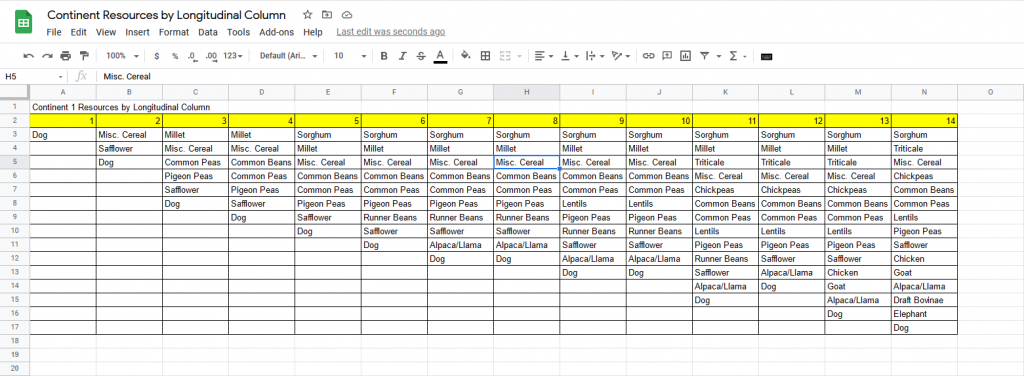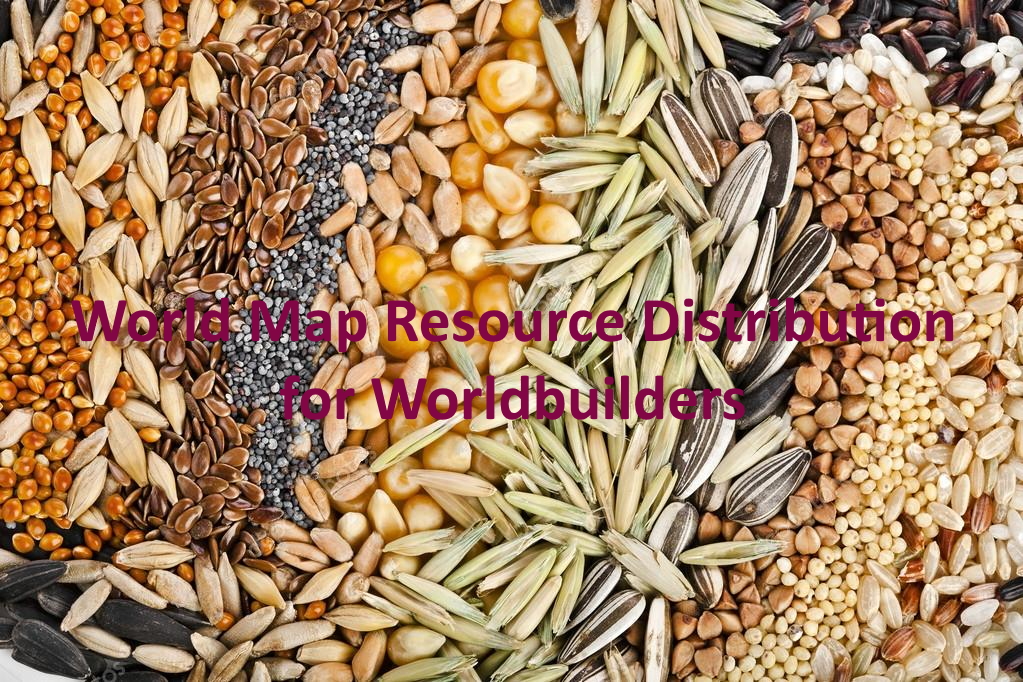Welcome back to the Worldbuilding Process. If you’ve been working alongside the blog, your world should really be coming together now. We started early on working on the basic concepts that would drive the world and how it would be different than the basic assumptions of fantasy worldbuilding. Then we followed up with the development of our world map. At this point, you should have a nice world map that can serve you writing stories or running roleplaying games for the rest of your life. Today, we’re going to take that excellent, natural map and start adding some context as to what inhabits the world. That means resources world map distribution.
Whether you’re a Dungeon Master or a writer, you create and weave stories about people. So, the focus for our resource distribution is things that are useful to people, communities, and civilizations. For example, we’re less concerned about the type of rabbit that lives in a specific area of the world and more concerned with what their staple agricultural crop and potential exports might be.
The process of allocating resources to your world map will take a little time. To put it in perspective, we’re looking at tracking roughly 60 resources and their distribution across the world. The whole process of distributing resources takes time, but it is not a complicated or difficult task. My suggestion is to put on a podcast or other accompaniment media and use this as relaxation while doing something productive for your worldbuilding.
How to Distribute Resources on Your World Map
There are many different ways to distribute resources on your world map, and none of them are wrong. I’ve tried a few different methods, but I settled on using a longitudinal column distribution method in the end. If you remember, way back in the Continents Hex Mapping Section, I shifted my world map to ensure the longitudinal edge of my map didn’t split one of my continents. Therefore, I don’t need to worry about wrapping resources around the edge of my map either.
Here’s how I distributed resources on my world map. For each resource I roll 1d60 (1d6+1d10) twice. Following my map columns, labeled 1-60, the most Westerly result is the start of the resource, and the most Easterly result is the end. To keep track of everything, I created a simple spreadsheet with 60 columns and simply added each new resource to the affected columns. That way, when I need to develop a settlement, I can refer back to this longitudinal list and assign resources based on the settlement’s biome and topography.

This distribution method does create some interesting results, which I believe is a strength rather than a weakness. For example, you could end up with pigs only appearing over ocean longitudes. So for your world, pigs may be an exotic animal, like the Galapagos tortoise, only found on a specific island chain.
The longitudinal column method means I don’t need to consider the specific biome for each resource. Since potatoes prefer cooler climates, they aren’t likely to grow in tropical areas of their longitudinal column unless there is a mountainous area where the elevation allows for crop diversity like the terrace farming practiced by the Inca. In that way, the longitudinal columns inform where the resources MIGHT appear rather than definitively appear.
The Essential Resources to Distribute on World Maps
You can track as many resources as you like on your world map, and this section can be a never-ending rabbit hole of world building. However, we want to focus first and foremost on the absolute essential resources that need distribution on your world map. The first being complementary staple crops.
Staple Crops & Plant-Based Complete Proteins
As worldbuilders, you are likely familiar with the seven characteristics of a civilization. The first and most important characteristic is a stable food supply. That means agriculture must progress past subsistence farming to create a food surplus. What I find widely overlooked is the importance of providing a complete protein through agriculture because most low social class people did not have reliable access to good sources of complete (animal) proteins like meat, eggs, and dairy in their diet.
Creating a complete plant-based protein is done through a diet foundation of two complementary incomplete plant proteins. This combination is so common and elemental to food culture around the world you already recognize it. It is simply a pairing of a lysine amino acid providing food and a methionine amino acid providing food.
Most commonly, a complete protein vegetarian diet is a synthesis of staple cereal and legume crops. The latter is widespread because most legume crops are nitrogen-producing crops. Unlike most crops, legumes put Nitrogen, the nutrient most leached through agriculture, back into the soil, making them a cornerstone of successful crop rotation and agricultural land management.

Common examples of complementary crops include rice and soybeans (tofu), corn (tortilla) and beans, wheat (bread) and peanut butter, plus potatoes and peas. These types of food combinations are consistent throughout the world wherever large populations of people developed. You will now be able to see these combinations in the food you eat and improve your cooking by understanding this essential pairing.
Below are the typical Cereal (Lysine) and Legume/Pulse (Methionine) staple crops for you to distribute across your world map.
Cereal Staple Crops
- Corn
- Rice
- Wheat
- Barley
- Sorghum
- Millet
- Oats
- Rye
- Triticale
- Miscellaneous (Fonio, Spelt, Teff, Amaranth, Buckwheat, Quinoa, etc.)
Legume/Pulse Staple Crops
- Chickpeas
- Common Beans
- Common Peas
- Fava Beans
- Lentils
- Lima Beans
- Lupins/Vetch
- Mung Beans
- Peanuts
- Pigeon Peas
- Runner Beans
- Soybeans
Auxiliary Complete Protein Crop Resources for Your World Map

After distributing your cereal and legume crops, you may realize there are sections of your map lacking one or both of these crop types. That doesn’t necessarily mean that a population can’t develop there, but they may not succeed at scaling to feed a large population. There are auxiliary plant-based crops that can create complete plant-based proteins. Here are some common examples you may want to consider adding to your map.
Additional Starch Crops (Lysine)
- Potato
- Cassava
- Sweet Potato
- Yam
- Plantain
Seeds/Nuts (Methionine)
- Almond
- Brazil Nut
- Cashew
- Flax Seed*
- Hazelnut
- Macadamia
- Pecan
- Pine Nut
- Pistachio
- Pumpkin Seed
- Sesame Seed
- Sunflower
- Walnut
*Flax is a super crop because of its versatility. If you choose to distribute flax at this point, make sure you use the same distribution for flax oil (cooking), linseed oil (lubricant/fuel), and linen, all products of flax.
And of course, if people in a part of your world still cannot create a complete plant protein, they will more heavily emphasize coastal fishing and livestock (dairy & meat). This inability often precludes large populations, and in some instances, they may find more success through a pastoral or nomadic lifestyle and forgo building large, sedentary population centers.
Essential Resources World Map: Oil-Producing Crops

Before the modern age, animal and plant products provided the world’s oil needs. These oils encompassed many aspects of daily living, such as cooking oil/fat, lighting, lubrication, skincare and beauty products, waterproofing, soap, and preventing rust. Because of the importance oil plays in many aspects of daily life, we want to know where people source it.
Any population that doesn’t get oil produced by one of the below crops will instead substitute animal-based products like rendered fat, lanolin (sheep), and beeswax.
Oil Producing Plants
- Avocado
- Canola/Rapeseed
- Coconut
- Corn*
- Cottonseed*
- Flaxseed/Linseed*
- Hempseed*
- Olive
- Palm
- Peanut*
- Safflower
- Soybean*
- Sunflower*
*These crops are mentioned in other sections. Ensure you don’t duplicate their resource distribution.
Domesticated Animals
For any pre-industrial setting, agriculture and crop availability considerably impact how people in your world operate. Of equal importance is the domestication of animals. For our purposes, it’s important to note we are discussing domesticated animals and not tame animals. These are animals that people have altered through countless generations of animal husbandry to be more beneficial to humans and create a very loose symbiotic relationship.
When we talk about domesticated animals, they come in two different types, product and labor animals. Product animals were domesticated for their products, not as a source of labor. The value comes from the dairy, meat, hide, or other animal byproducts they provide. For example, leather may be costly if a suitable domestic animal is not common to the region.
Conversely, people domesticated labor animals to serve as a source of work and perform specific tasks better or cheaper than people. Access to domesticated labor animals can significantly affect your people’s food, production capabilities, and travel. Case in point, travel in Pre-Columbian Americas was almost exclusively by foot before the introduction of the horse.
Product Domesticated Animals
- Chicken
- Dairy/Meat Bovinae (Cow, Yak, etc.)
- Goat
- Honey Bee
- Llama/Alpaca*
- Pig
- Sheep
- Silkworm
Labor Domesticated Animals
- Camel
- Dog
- Donkey**
- Draft Bovinae (Ox, Water Buffalo)
- Horse
- Llama/Alpaca
*Also traditionally used for labor if other labor animals are not available
**Where donkey and horse populations overlap, mules will also exist and be sought after as labor animals
Essential Resources World Map Distribution, Part II
We’ll continue adding more resources to our world map in part two. In the next section, we will look at more essential resources you will want to consider adding to your map for world building, such as textiles, intoxicants, additional foods, and strategic resources like minerals and metals.
For now, take a look at where resources appear on your map and consider the distribution implications. On my world map, rice, wheat, and barley occupy a small section of the map. I know starting off that food in my setting will have much more variety and a more significant emphasis on the production of rye, sorghum, triticale, and minor cereals like amaranth, fonio, and teff.

That also means the production of traditional, barley malt beer occurs in a tiny area of the world. Something ubiquitous and cheap in most fantasy worlds will be an expensive and rare export. Conversely, Alpaca/Llama are widespread and found across two-thirds of my setting. I suspect their wool will be integral to the setting’s textiles, and they will often serve as pack animals, especially in highland areas.
What to Do Next?
While you’re waiting on me to write the next post, why don’t you check out some of the other things I’ve written about on the RedRaggedFiend blog to improve your D&D or preferred RPG games? Check out the last blog, How I Improved My D&D Homebrew Adventures, where I talk about some of the recent updates I’ve made to my Adventure Skeleton template.
If you like what you see here, spread it to the world. Please tag me on Twitter! I don’t run ads on the website, use affiliate links, or have any sponsored content, so if you’d like to help me keep things moving, you can support me with as little as $1 on ko-fi or check out my PWYW titles on DriveThruRPG.


Pingback: World Map Essential Resource Distribution, Part II | Red Ragged Fiend